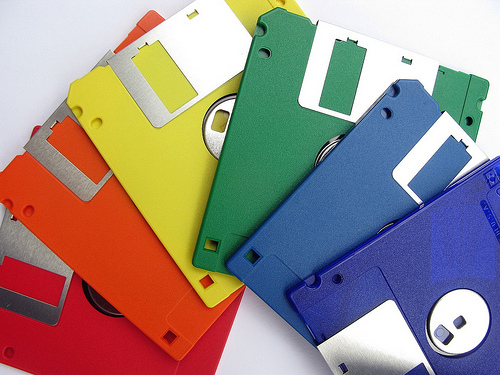Checking out floppy disks is like taking a trip to the past.
- Floppy disks are an invention, formerly used to store computer data, that were read by a disk drive.
- ‘Floppy disks’ are also known simply as ‘disks’, ‘flexible disks’ and ‘diskettes’, and were once called ‘memory disks’.
- There were three main sizes of floppy disks – the 8 inch (20 centimetres), 5.25 inch (13 centimetres) and 3.5 inch (9 centimetres), and the larger disks were the older designs.
- Floppy disks were invented through an IBM development team headed by David Noble, that created the original invention between 1967 and 1971.
- Floppy disks were of a square shape, initially with a hole in the centre; typically consisting of a plastic case which was originally floppy, but a hard case was used for the 3.5 inch version; with a thin, circular piece of magnetic material inside.
Floppy Disks
Image courtesy of Frankie Leon/Flickr
- Floppy disks were first sold commercially in 1971 and were initially produced as part of a drive that was read-only, and used for the purpose of placing already written microcode, onto mainframe computers; and they soon became portable and independent forms of media.
- Being a practical method of distributing and storing data in its time, floppy disks had become extremely widespread among the general population by the 1980s and 1990s, especially after designs were continuously refined.
- A magnetic reader mechanism was used to read and write on floppy disks, and the magnetic material would spin rapidly inside the casing of the disk when the reader was in use.
- Floppy disks were known as “floppy”, due to the flexible material of the original designs in particular; and in the earlier designs, the plastic casing surrounding the actual magnetic disk included a fabric lining which cleaned the disk as it spun.
- Floppy disks dropped in popularity by the 2000s, as USBs and CDs capable of storing greater data quantities became available, with the floppy technology becoming almost non-existent in new computers by 2007.
Bibliography:
1971: Floppy disk loads mainframe computer data, n.d, The Storage Engine, http://www.computerhistory.org/storageengine/floppy-disk-loads-mainframe-computer-data/
Bellis M, The Invention of the Floppy Disk Drive, 2014, About Money, http://inventors.about.com/od/computersandinternet/a/FloppyDisk.htm
Floppy Disk, 2016, Wikipedia, https://en.wikipedia.org/wiki/Floppy_disk
Mason H, The History of the Floppy Disk, 2015, Geek & Sundry, http://geekandsundry.com/the-history-of-the-floppy-disk/






